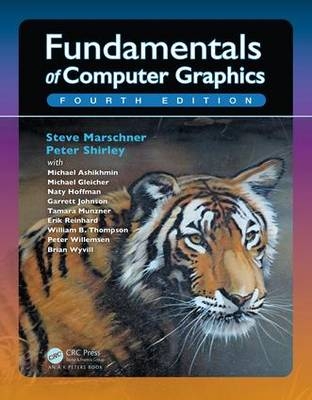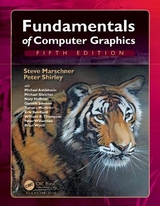
Fundamentals of Computer Graphics
Apple Academic Press Inc. (Verlag)
978-1-4822-2939-4 (ISBN)
- Titel erscheint in neuer Auflage
- Artikel merken
Focusing on geometric intuition, the book gives the necessary information for understanding how images get onto the screen by using the complementary approaches of ray tracing and rasterization. It covers topics common to an introductory course, such as sampling theory, texture mapping, spatial data structure, and splines. It also includes a number of contributed chapters from authors known for their expertise and clear way of explaining concepts.
Highlights of the Fourth Edition Include:
Updated coverage of existing topics
Major updates and improvements to several chapters, including texture mapping, graphics hardware, signal processing, and data structures
A text now printed entirely in four-color to enhance illustrative figures of concepts
The fourth edition of Fundamentals of Computer Graphics continues to provide an outstanding and comprehensive introduction to basic computer graphic technology and theory. It retains an informal and intuitive style while improving precision, consistency, and completeness of material, allowing aspiring and experienced graphics programmers to better understand and apply foundational principles to the development of efficient code in creating film, game, or web designs.
Key Features
Provides a thorough treatment of basic and advanced topics in current graphics algorithms
Explains core principles intuitively, with numerous examples and pseudo-code
Gives updated coverage of the graphics pipeline, signal processing, texture mapping, graphics hardware, reflection models, and curves and surfaces
Uses color images to give more illustrative power to concepts
Steve Marschner, Cornell University, Ithaca, New York, USA Peter Shirley, Purity LLC
Introduction
Graphics Areas
Major Applications
Graphics APIs
Graphics Pipeline
Numerical Issues
Efficiency
Designing and Coding Graphics Programs
Miscellaneous Math
Sets and Mappings
Solving Quadratic Equations
Trigonometry
Vectors
Curves and Surfaces
Linear Interpolation
Triangles
Raster Images
Raster Devices
Images, Pixels, and Geometry
RGB Color
Alpha Compositing
Ray Tracing
The Basic Ray-Tracing Algorithm
Perspective
Computing Viewing Rays
Ray-Object Intersection
Shading
A Ray-Tracing Program
Shadows
Ideal Specular Reflection
Historical Notes
Linear Algebra
Determinants
Matrices
Computing with Matrices and Determinants
Eigenvalues and Matrix Diagonalization
Transformation Matrices
2D Linear Transformations
3D Linear Transformations
Translation and Affine Transformations
Inverses of Transformation Matrices
Coordinate Transformations
Viewing
Viewing Transformations
Projective Transformations
Perspective Projection
Some Properties of the Perspective Transform
Field-of-View
The Graphics Pipeline
Rasterization
Operations Before and After Rasterization
Simple Antialiasing
Culling Primitives for Efficiency
Signal Processing
Digital Audio: Sampling in 1D
Convolution
Convolution Filters
Signal Processing for Images
Sampling Theory
Surface Shading
Diffuse Shading
Phong Shading
Artistic Shading
Texture Mapping
Looking Up Texture Values
Texture Coordinate Functions
Antialiasing Texture Lookups
Applications of Texture Mapping
Procedural 3D Textures
Data Structures for Graphics
Triangle Meshes
Scene Graphs
Spatial Data Structures
BSP Trees for Visibility
Tiling Multidimensional Arrays
More Ray Tracing
Transparency and Refraction
Instancing
Constructive Solid Geometry
Distribution Ray Tracing
Sampling
Integration
Continuous Probability
Monte Carlo Integration
Choosing Random Points
Curves
Curves
Curve Properties
Polynomial Pieces
Putting Pieces Together
Cubics
Approximating Curves
Summary
Computer Animation
Principles of Animation
Keyframing
Deformations
Character Animation
Physics-Based Animation
Procedural Techniques
Groups of Objects
Using Graphics Hardware
Hardware Overview
What Is Graphics Hardware
Heterogeneous Multiprocessing
Graphics Hardware Programming: Buffers, State, and Shaders
State Machine
Basic OpenGL Application Layout
Geometry
A First Look at Shaders
Vertex Buffer Objects
Vertex Array Objects
Transformation Matrices
Shading with Per-Vertex Attributes
Shading in the Fragment Processor
Meshes and Instancing
Texture Objects
Object-Oriented Design for Graphics Hardware Programming
Continued Learning
Light
Radiometry
Transport Equation
Photometry
Color
Colorimetry
Color Spaces
Chromatic Adaptation
Color Appearance
Visual Perception
Vision Science
Visual Sensitivity
Spatial Vision
Objects, Locations, and Events
Picture Perception
Tone Reproduction
Classification
Dynamic Range
Color
Image Formation
Frequency-Based Operators
Gradient-Domain Operators
Spatial Operators
Division
Sigmoids
Other Approaches
Night Tonemapping
Discussion
Implicit Modeling
Implicit Functions, Skeletal Primitives, and Summation Blending
Rendering
Space Partitioning
More on Blending
Constructive Solid Geometry
Warping
Precise Contact Modeling
The Blob Tree
Interactive Implicit Modeling Systems
Global Illumination
Particle Tracing for Lambertian Scenes
Path Tracing
Accurate Direct Lighting
Reflection Models
Real-World Materials
Implementing Reflection Models
Specular Reflection Models
Smooth-Layered Model
Rough-Layered Model
Computer Graphics in Games
Platforms
Limited Resources
Optimization Techniques
Game Types
The Game Production Process
Visualization
Background
Data Types
Human-Centered Design Process
Visual Encoding Principles
Interaction Principles
Composite and Adjacent Views
Data Reduction
Examples
| Zusatzinfo | Need binder: SIGGRAPH (Aug 11-13 2015) -- I know the book won't make it but we'll need a binder.; Approx. 1628 equations; 1 Tables, color; 541 Illustrations, color |
|---|---|
| Verlagsort | Oakville |
| Sprache | englisch |
| Maße | 191 x 235 mm |
| Gewicht | 1724 g |
| Themenwelt | Informatik ► Grafik / Design ► Film- / Video-Bearbeitung |
| ISBN-10 | 1-4822-2939-0 / 1482229390 |
| ISBN-13 | 978-1-4822-2939-4 / 9781482229394 |
| Zustand | Neuware |
| Informationen gemäß Produktsicherheitsverordnung (GPSR) | |
| Haben Sie eine Frage zum Produkt? |
aus dem Bereich



